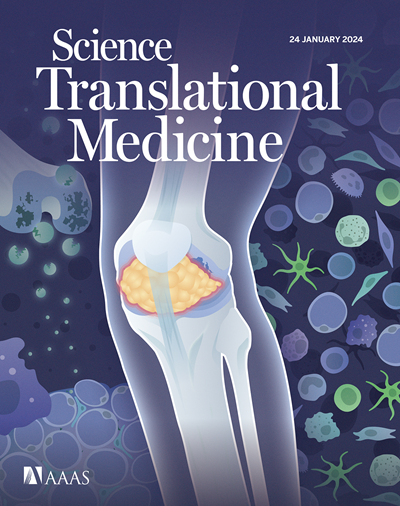在临床前模型中,使用缓释抗jun治疗可以消除术后粘连
IF 15.8
1区 医学
Q1 CELL BIOLOGY
引用次数: 0
摘要
术后腹部粘连是肠梗阻的主要原因,也是慢性疼痛和不孕的原因之一。粘连的形成发生在50%到90%的腹部手术后,并且没有被证实的预防或治疗策略。腹腔粘连主要来自内脏腹膜,由多克隆增殖的组织常驻成纤维细胞组成。我们之前已经表明,转录因子JUN的信号传导调节粘连发生,并且小分子JUN抑制剂(T-5224)减少粘连形成。在这里,我们将T-5224包裹在具有抗粘连特性的剪切稀释水凝胶中,用于腹腔术后给药,并持续释放JUN抑制剂以预防粘连。t -5224水凝胶的材料特性支持其用于开放或微创手术应用。我们发现这种治疗系统在小鼠和猪临床前模型中是安全的,耐受性良好且有效的。t -5224水凝胶在超微结构水平上减少了粘附量,也减少了粘附纤维化。向临床转化,我们开发了一个大型哺乳动物粘连模型的猪肠切除术。单细胞转录组学分析显示,在t -5224水凝胶处理的黏附源成纤维细胞中,JUN和相关通路信号通路减少。抑制jun的t -5224水凝胶提供了强大的粘连预防,而不会对肠吻合或腹壁愈合产生有害影响。粘附生物学在手术部位是相似的,因此,这种配方有可能适用于全身。预防粘连的治疗方法的发展是至关重要的,具有潜在的高影响转化为患者护理,以解决一个共同的,未满足的临床需求。本文章由计算机程序翻译,如有差异,请以英文原文为准。
Postoperative adhesions are abrogated by a sustained-release anti-JUN therapeutic in preclinical models
Postoperative abdominal adhesions are the leading cause of bowel obstruction and a cause of chronic pain and infertility. Adhesion formation occurs after 50 to 90% of abdominal operations and has no proven preventative or treatment strategy. Abdominal adhesions derive primarily from the visceral peritoneum and are composed of polyclonally proliferating tissue-resident fibroblasts. We have previously shown that signaling of the transcription factor JUN regulates adhesiogenesis and that a small-molecule JUN inhibitor (T-5224) decreases adhesion formation. Here, we encapsulated T-5224 in a shear-thinning hydrogel with antiadhesion properties for intraperitoneal postoperative delivery and sustained release of a JUN inhibitor for adhesion prevention. The material properties of the T-5224–hydrogel support its use for open or minimally invasive surgical application. We found this therapeutic system to be safe, well tolerated, and efficacious in murine and porcine preclinical models. T-5224–hydrogel minimized adhesion quantity and also diminished adhesion fibrosis at an ultrastructural level. Moving toward clinical translation, we developed a large mammal adhesion model in pigs with bowel resection. Single-cell transcriptomic analysis showed that JUN and associated pathway signaling were diminished in adhesion-derived fibroblasts treated with T-5224–hydrogel. The JUN-inhibiting T-5224–hydrogel provided robust prevention of adhesion without deleterious effects on bowel anastomosis or abdominal wall healing. Adhesion biology is similar across surgical sites, and, therefore, this formulation has potential for applicability across the body. The development of therapeutics to prevent adhesions is of paramount importance with potential for high-impact translation to patient care to address a common, unmet clinical need.
求助全文
通过发布文献求助,成功后即可免费获取论文全文。
去求助
来源期刊

Science Translational Medicine
CELL BIOLOGY-MEDICINE, RESEARCH & EXPERIMENTAL
CiteScore
26.70
自引率
1.20%
发文量
309
审稿时长
1.7 months
期刊介绍:
Science Translational Medicine is an online journal that focuses on publishing research at the intersection of science, engineering, and medicine. The goal of the journal is to promote human health by providing a platform for researchers from various disciplines to communicate their latest advancements in biomedical, translational, and clinical research.
The journal aims to address the slow translation of scientific knowledge into effective treatments and health measures. It publishes articles that fill the knowledge gaps between preclinical research and medical applications, with a focus on accelerating the translation of knowledge into new ways of preventing, diagnosing, and treating human diseases.
The scope of Science Translational Medicine includes various areas such as cardiovascular disease, immunology/vaccines, metabolism/diabetes/obesity, neuroscience/neurology/psychiatry, cancer, infectious diseases, policy, behavior, bioengineering, chemical genomics/drug discovery, imaging, applied physical sciences, medical nanotechnology, drug delivery, biomarkers, gene therapy/regenerative medicine, toxicology and pharmacokinetics, data mining, cell culture, animal and human studies, medical informatics, and other interdisciplinary approaches to medicine.
The target audience of the journal includes researchers and management in academia, government, and the biotechnology and pharmaceutical industries. It is also relevant to physician scientists, regulators, policy makers, investors, business developers, and funding agencies.
 求助内容:
求助内容: 应助结果提醒方式:
应助结果提醒方式:


